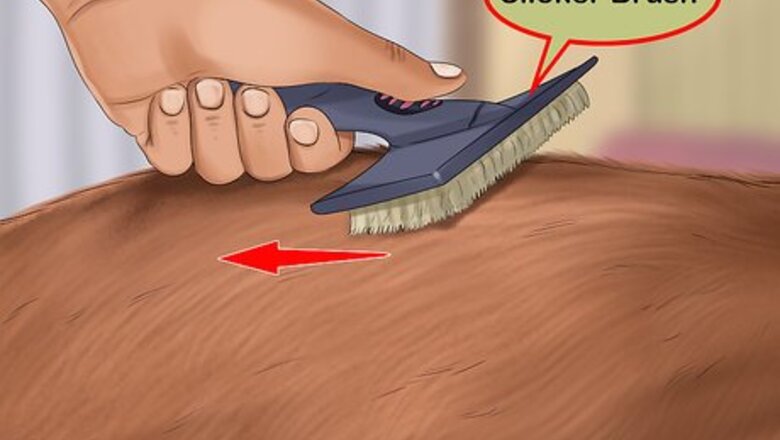
views
Developing a Cleaning Routine
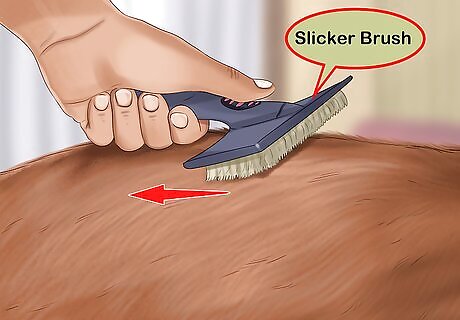
Brush your border terrier’s coat daily with a slicker brush. Regular brushing removes dead hair and helps keep your dog’s coat clean. Gently run the slicker brush through the coat in the direction that it grows. If you encounter a mat, spray it with conditioner or mat spray, hold the base of the fur, and work at the mat with a metal comb. Use smooth, slow motions, and be sure not to brush hard or scrape your dog’s skin. A slicker brush is covered with fine wire pins. It’s designed to remove dead hair, mats, and debris from fur, and is the best grooming tool for double-coated dogs. You can buy one online or at your local pet supply store. If you can't brush daily, at least try to do it once a week.
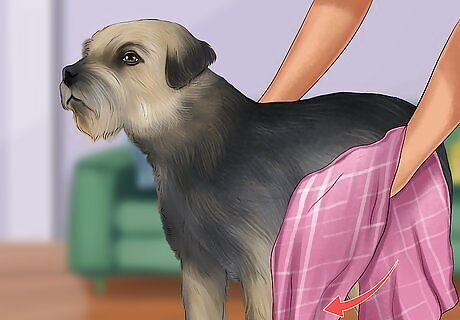
Wipe its underside with a damp cloth as needed. While you brush, check your dog’s belly, bottom, and genital area. Remove any soil from these areas with a damp cloth or a wet wipe. If you use wet wipes, make sure they’re safe to use on dogs. Choose baby wipes or cleansing wipes labeled for dogs instead of harsher wipes meant for household cleaning.
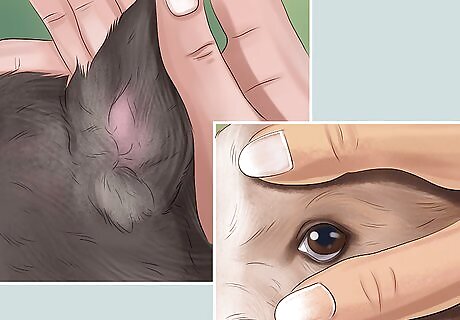
Check its eyes, ears, and whiskers for buildup daily. When you brush its coat, look for buildup in the corners of its eyes, in its eyebrows, and inside of its ears. Check its whiskers, or the fur around its muzzle, for dirt or food residue. If necessary, remove any buildup from these areas with a damp cloth or a wet wipe. Wipe gently toward the corners of its eyes. Avoid coming into contact with the eye itself. Lift an ear and wipe any buildup away from the hairs and the skin inside. Dry the insides of the ears after wiping them with the damp cloth.
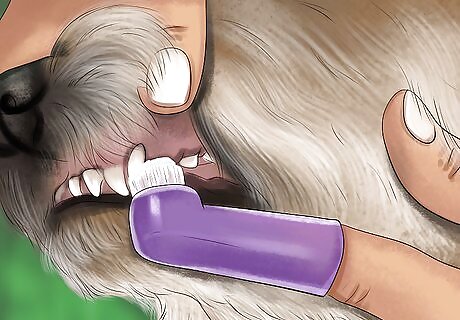
Clean your dog’s teeth every day. Use a small pet toothbrush and toothpaste labeled for dogs. Gently lift your dog’s lip and brush its teeth with circular motions. Have patience if it resists, and reassure it with lots of praise. Be sure the toothpaste is marked safe for pets. Your dog will get sick if it swallows toothpaste made for humans. If your dog resists having its teeth brushed, try using a flavored toothpaste. Chicken flavored toothpaste usually does the trick.
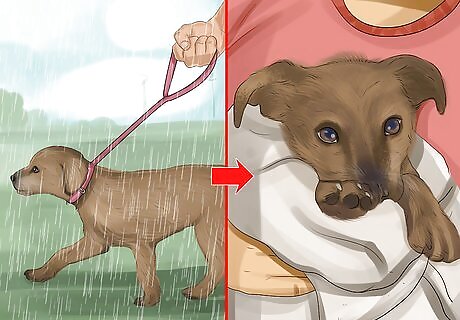
Towel dry and brush your dog after a walk in the rain. When your border terrier’s coat gets wet, you should only need to dry it off with a clean towel. Since its coat is waterproof, you probably won’t need to blow dry it. After towel drying it, run the slicker brush through its coat. If you do need to blow dry your border terrier, use a low, cool or warm setting. Hold the blow dryer at least 1 foot (30 cm) away from your dog, and avoid blowing directly in its face.
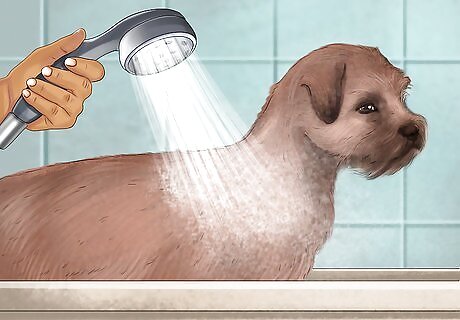
Bathe your border terrier only if it’s absolutely necessary. If your dog is filthy, rinse its fur with warm water in a sink or bathtub. Use dog shampoo labelled for terriers or wiry-coated dogs only if warm water isn’t effective. After giving it a bath, dry it with a towel, blow dry it if you want to speed the drying process, and then brush it. A border terrier’s coarse outer coat is waterproof and keeps dirt away from the undercoat and skin. Bathing removes the coat’s oil and softens its texture. Without its oil and wiry texture, the coat loses its repellent properties.
Maintaining Its Paws and Nails
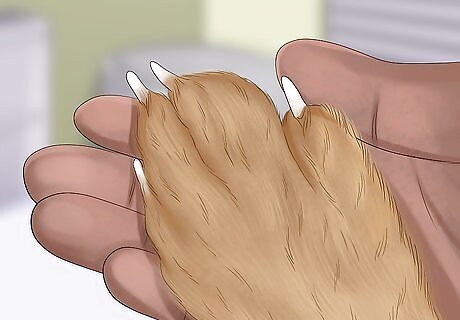
Handle your dog’s paws often so it’s used to having them touched. Hold and stroke your dog’s paws daily, and reward calm behavior with praise and treats. Frequent handling and rewards will help it form a positive association with having its paws touched. Most dogs don’t like having their paws handled. Trimming its nails and the fur around its paw pads is delicate, and your dog needs to remain still during handling to avoid accidental injuries.
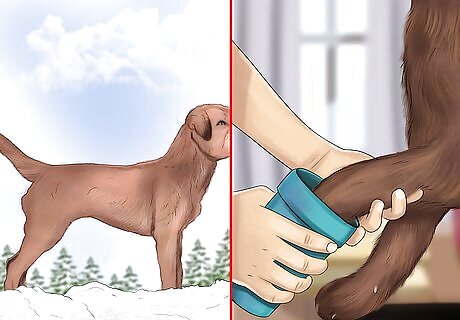
Wipe snow and salt from its paws after walks in the winter. If you live in a cold climate, add winter care to your daily grooming routine. After each walk, wipe your dog’s paws with a warm, damp cloth or wet wipe, and towel dry its body if it gets wet. Massaging petroleum jelly into your dog’s paw pads can help protect them from snow, salt, and chemicals. Snow, salt, and de-icing chemicals can be irritating or poisonous. When you wipe your dog’s paws after walks, check the pads and lower legs for chafing and redness. If you see signs of irritation, apply witch hazel or soak your dog’s paws in 1 gallon (3.8 L) of warm water and ⁄2 to 1 cup (120 to 240 mL) of Epsom salt for at least 10 minutes.

Clip its nails 1 to 2 times per month. Trim your dog’s nails regularly and in small amounts to avoid nicking a quick, or a nail’s sensitive root. As a rule of thumb, trim your dog's nails every 2 to 3 weeks, or whenever you can hear them click when it walks on hard surfaces.
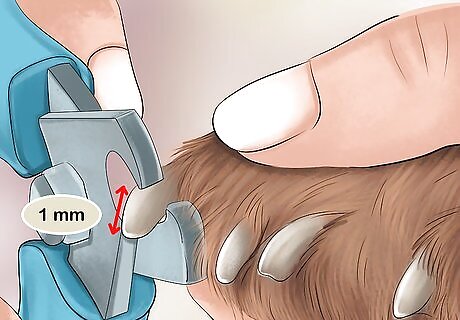
Trim about 1 mm (0.039 in) from the curve of a nail. Grasp a paw firmly but gently, and use curved clippers designed for dogs to trim the end of a nail. Clip only the end of the nail, and avoid cutting into the curve. Doing so would risk nicking the quick. If your dog resists, aim to trim only 1 to 2 nails at a time, then give it a break. If you cut the quick, stop the bleeding by gently packing it with baking soda or by holding a bar of soap to the paw for 3 to 4 minutes. Do your best to reassure your dog with calm praise. Bandage the paw when the bleeding stops, and call the vet if you can't control the bleeding.
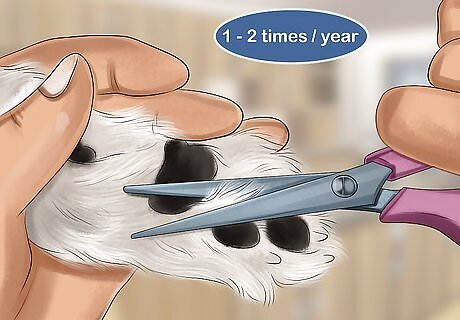
Trim the fur between its paw pads at least 1 to 2 times a year. Use blunt safety scissors to trim the hair that grows between its paw pads and around its nails. Hold the scissors flat against the paw pads instead of pointing them toward the foot. Cut only around the bottom of your dog’s feet; the hair at the top can be stripped by hand. Remove enough hair so that none covers the paw pads. You should be able to see the pads clearly. Trim your border terrier’s feet every 5 to 6 months, or when its hair begins to cover the pads. Excess hair around the paw pads collects grime and makes it harder for your dog to walk without slipping.
Stripping Your Border Terrier’s Coat
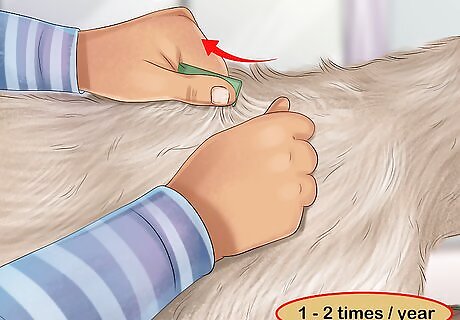
Strip your border terrier’s coat 1 to 2 times per year. Unlike humans and most other dogs, border terriers’ hair stops growing and dies after 5 to 6 months. The old, dead coat should then be hand-plucked so a new coat can grow in its place. Your dog is ready to be stripped when its coat is so long that it forms a part down the center of its back. Stripping is the process of pulling out dead hair by hand. It’s a common grooming practice for wiry, double-coated terriers. Since the hair is dead, it’s easy to pluck out without causing any pain. With practice, you might be able to strip the entire coat in around 30 to 60 minutes. However, it will most likely take several 30 to 60 minute sessions if you’re a beginner. You should not cut a border terrier’s coat with electric clippers. Clipping ruins the coat’s texture and color, and causes it to lose its ability to repel dirt and water.

Stand your dog on a non-slip surface. If you’re confident that your dog won’t try to jump away, place it on a table that’s high enough for you to work comfortably. It’s helpful to have your dog stand on a non-slip mat. If its paw pads are covered with overgrown hair, it might have trouble standing on a smooth tabletop without slipping. Some owners simply strip their border terrier while cuddling on the sofa. This is a good option if you can’t get your dog to stand on a table for 30 minutes. However, you’ll have an easier time seeing its natural lines and stripping it evenly if it’s standing. You’ll probably need to work in several short sessions, especially the first few times you strip the coat. If it’s not used to being stripped, your dog will probably only tolerate 10 or 15 minute sessions.

Pull its hide tight and pinch a few strands of dead hair. Use one hand to grasp the skin in the area that you’re plucking. Gently pull the skin flat so it’s tight and won’t move when you pluck the hair. With your other hand, test the coat by pinching at a few hairs with your thumb and index finger. You shouldn't encounter much resistance when you pinch and tug. If dead hair doesn't come out easily, the coat isn't ready to be stripped. If necessary, try again in 1 to 2 weeks.

Pluck hair out in the direction that it grows. After testing the coat, pluck a pinch of hair at a time with firm, quick motions. Pluck the hair out in the direction that the coat grows. In general, the coat grows toward the tail. Hair that covers the limbs grows toward the feet. Your dog shouldn't jerk or yelp as if it felt pain. If the hair doesn't come out easily or if plucking seems to hurt your dog, the coat isn't ready to be stripped. It might be helpful to look at a visual reference while you strip. Search online or in a dog breed guidebook for pictures of freshly stripped border terriers.
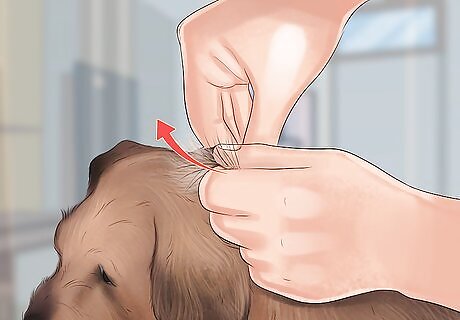
Start behind its head and work your way down its back. The easiest place to start is behind your dog’s neck and shoulders. Stand behind it, grasp a patch of skin, and pluck of pinch of old hair toward yourself (toward the dog’s tail). Continue stripping its back in small, even sections. Your dog might be confused or alarmed the first time you strip its coat. Reassure it with generous praise and have its favorite treats handy. Try to pluck for at least 10 to 15 minutes, but don’t force your dog if gets stressed. Take a break, and make another attempt when your dog is mellow.
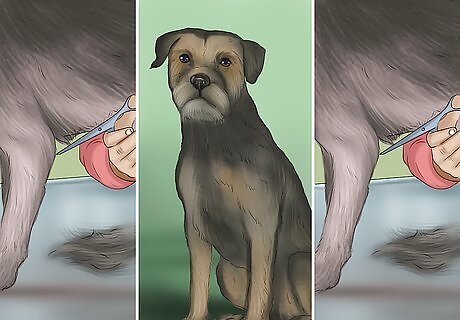
Give it plenty of breaks when you strip its flank, belly, and bottom. After stripping your dog's back, move on to the sides of it body, stomach, and rear end. Remember to hold the skin flat, and pluck a few hairs at a time in small sections. These areas are more sensitive than the back, so take breaks whenever your dog gets antsy. While it might be a bit tedious, stripping is relatively simple. Just be patient, and work little by little over the course of a few days if you or your dog get antsy. When you’re finished stripping the body, you should see your dog’s undercoat, and its appearance should be neat and tidy instead of shaggy and unkempt.
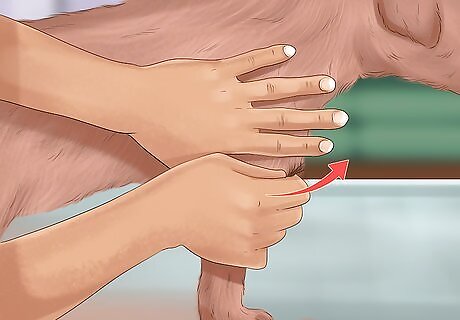
Strip the legs down the top of each foot. Pluck the hair on the front and back side of each limb. Hold the skin flat and pull small pinches of hair downward, or toward the feet. Strip the top of each foot, but leave the hair that grows over the paw pads. Use scissors to trim the hair that grows around the paw pads.
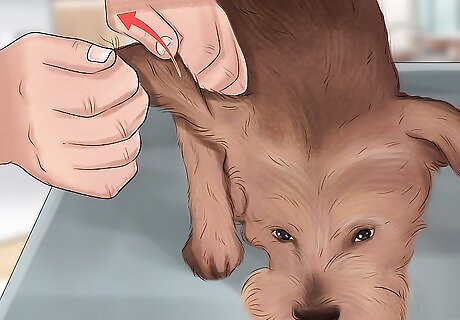
Move on to the head and ears. Pluck even smaller pinches from the head and face, as these areas require more attention to detail. Start by removing dead hair from the top of the head, down between the eyes, and around the edges of the eyes. Then carefully pluck tiny pinches of long, dead hair on the outside of its ears. Pluck hair on the ears toward the points of the ears. When stripping the head and face, it’s wise to have a visual reference on hand. For helpful images, search online for “border terrier head study.”
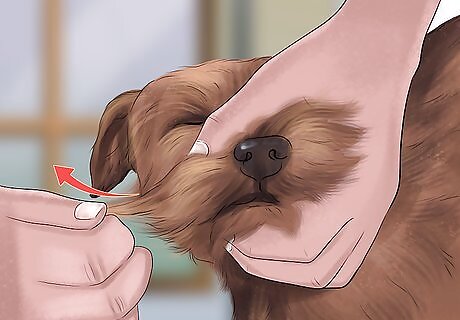
Tidy its face, but leave short whiskers around its muzzle. Border terriers shouldn’t have elaborate facial hair like other terrier breeds. However, you should leave short whiskers, or hair that grows around its muzzle. Pinch long, scraggly hairs to tidy the muzzle, then continue plucking along its jawline. Don’t leave a beard or long hair below the jawline. Step back often to make sure you’re stripping the face and muzzle evenly. Whiskers don’t grow as fast as the rest of the coat, so any mistakes will last for months.
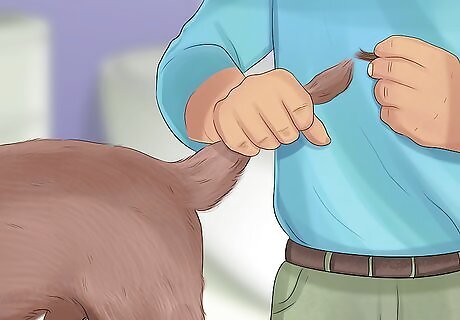
Taper your dog’s tail so it resembles a carrot. One way to taper the tail is strip it over the course of 3 to 4 weeks. When you strip the rest of your dog’s body, pluck the bottom third of the tail, or the base. Let the coat grow for 1 to 2 weeks, then strip the tail’s middle third. Finally, strip the final third, or the tip, 1 to 2 weeks after stripping the middle section. The base, middle, and tip will then grow at different rates, and the tail will come to a point like a carrot. The breed standard specifies a tapered tail. If you’re not worried about meeting the standard, just shape the tail into a point as best you can. Leave some hair at the base and gradually pluck more hair as you get to the tip. Pinch smaller amounts of fur around your dog’s rear end and tail, as these are sensitive areas.
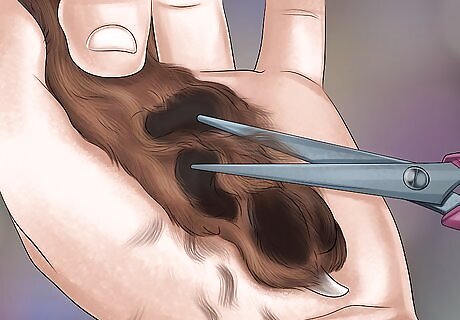
Trim the groin, inner hind legs, and paw pads with scissors. Use blunt safety scissors to carefully trim around the inner thighs, lower abdomen, and genitals. Then hold the scissors flat against the bottom of each foot and trim the hair that grows around the paw pads. The area between your dog’s hind legs is sensitive, and hair there doesn’t grow as long as the rest of its body. Just use scissors on the thin hair that covers the sensitive areas; the upper abdomen and chest should be plucked by hand.


















Comments
0 comment